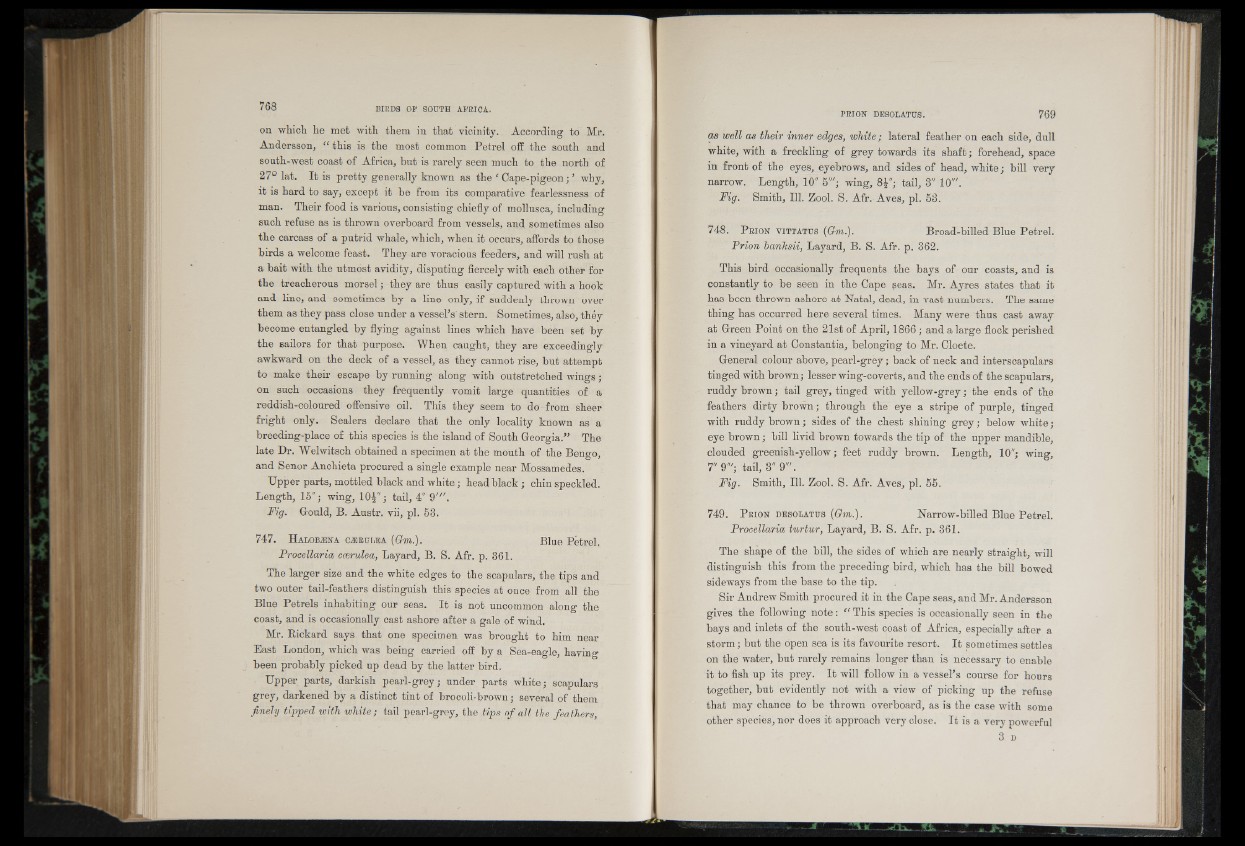
on -which he met with them in that vicinity. According? to Mr. 1 o
Andersson, “ this is the most common Petrel off the south and
south-west coast of Africa, hut is rarely seen much to the north of
27° lat. It is pretty generally known as the ' Cape-pigeon; ’ why,
it is hard to say, except it be from its comparative fearlessness of
man. Their food is various, consisting chiefly of mollusca, including
such refuse as is thrown overboard from vessels, and sometimes also
the carcass of a putrid whale, which, when it occurs, affords to those
birds a welcome feast. They are voracious feeders, and will rush at
a bait with the utmost avidity, disputing fiercely with each other for
the treacherous morsel; they are thus easily captured with a hook
and line, and sometimes by a line only, if suddenly thrown over
them as they pass close under a vessel’s stern. Sometimes, also, they
become entangled by flying against lines which have been set by
the sailors for that purpose. When caught, they are exceedingly
awkward on the deck of a vessel, as they cannot rise, but attempt
to make their escape by running along with outstretched wings;
on such occasions they frequently vomit large quantities of a
reddish-coloured offensive oil. This they seem to do from sheer
fright only. Sealers declare that the only locality known as a
breeding-place of this species is the island of South Georgia.” The
late Dr. Welwitsch obtained a specimen at the mouth of the Bengo,
and Senor Anchieta procured a single example near Mossamedes.
Upper parts, mottled black and white.; head black; chin speckled.
Length, 15"; wing, 10^"; tail, 4" 9"'.
Fig. Gould, B. Austr. vii, pi. 53.
747. Halobaina gerui.ea (Gm.). Blue Petrel.
Procellaria ccerulea, Layard, B. S. Afr. p. 361.
The larger size and the white edges to the scapulars, the tips and
two outer tail-feathers distinguish this species at once from all the
Blue Petrels inhabiting our seas. I t is not uncommon along the
coast, and is occasionally cast ashore after a gale of wind.
Mr. Rickard says that one specimen was brought to him near
East London, which was being carried off by a Sea-eagle, having
been probably picked up dead by the latter bird.
Upper parts, darkish pearl-grey; under parts white; scapulars
grey, darkened by a distinct tint of brocoli-brown; several of them
finely tipped with white; tail pearl-grey, the tips of all the feathers,
as well as their inner edges, white; lateral feather on each side, dull
white, with a freckling of grey towards its shaft; forehead, space
in front of the eyes, eyebrows, and sides of head, white; bill very
narrow. Length, 10" 5'"; wing, 8|"; tail, 3" 10'".
Fig. Smith, 111. Zool. S. Afr. Aves, pi. 53.
748. P r io n v itta tu s (Gm.). Broad-billed Blue Petrel.
Prion bariksii, Layard, B. S. Afr. p. 362.
This bird occasionally frequents the bays of our coasts, and is
constantly to be seen in the Cape seas. Mr. Ayres states that it
has been thrown ashore at Natal, dead, in vast numbers. The same
thing has occurred here several times. Many were thus cast away
at Green Point on the 21st of April, 1866; and a large flock perished
in a vineyard at Constantia, belonging to Mr. Cloete.
General colour above, pearl-grey; back of neck and interscapulars
tinged with brown; lesser wing-coverts, and the ends of the scapulars,
ruddy brown; tail grey, tinged with yellow-grey; the ends of the
feathers dirty brown; through the eye a stripe of purple, tinged
with ruddy brown; sides of the chest shining grey; below white;
eye brown; bill livid brown towards the tip of the upper mandible,
clouded greenish-yellow; feet ruddy brown. Length, 10"; wing,
7" 9'"; tail, 3" 9"'.
Fig. Smith, 111. Zool. S. Afr. Aves, pi. 55.
749. P rio n desolatus (Gm.). Narrow-billed Blue Petrel.
Procellaria turtur, Layard, B. S. Afr. p. 361.
The shape of the bill, the sides of which are nearly straight, will
distinguish this from the preceding bird, which has the bill bowed
sideways from the base to the tip.
Sir Andrew Smith procured it in the Cape seas, and Mr. Andersson
gives the following note: “ This species is occasionally seen in the
bays and inlets of the south-west coast of Africa, especially after a
storm; but the open sea is its favourite resort. It sometimes settles
on the -water, but rarely remains longer than is necessary to enable
it to fish up its prey. It will follow in a vessel’s course for hours
together, but evidently not with a view of picking up the refuse
that may chance to be thrown overboard, as is the case with some
other species, nor does it approach very close. It is a very powei'ful